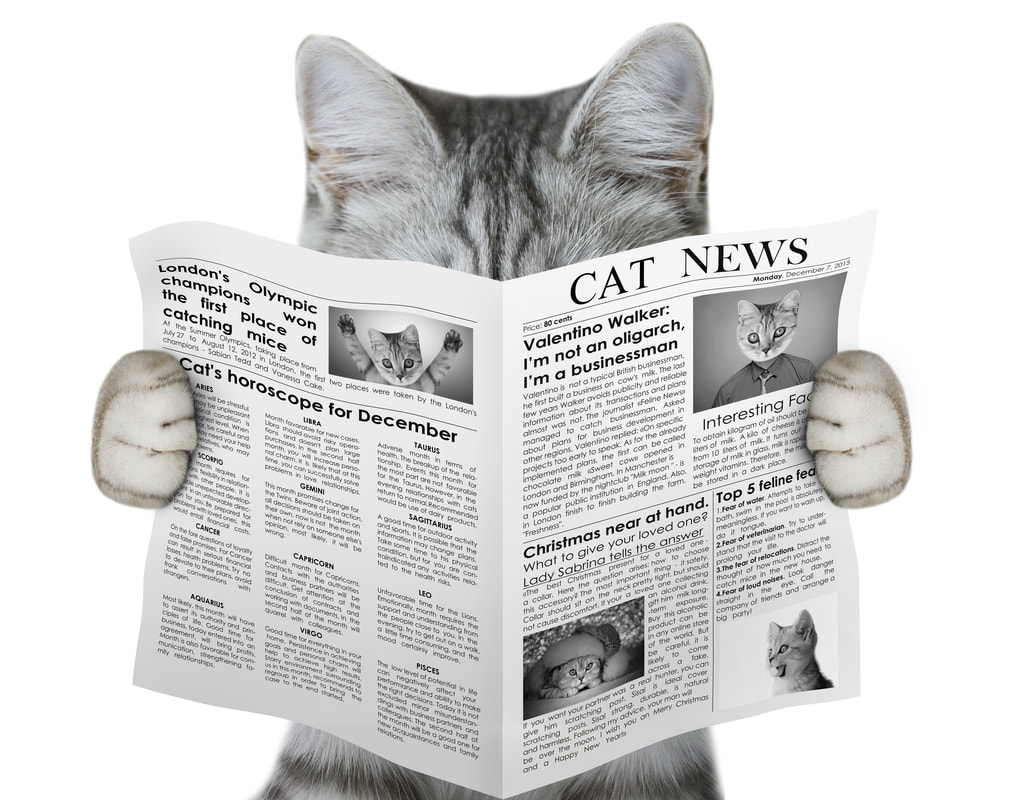 Bengal Cat Standards: The Bengal should be alert, friendly and affectionate and in excellent physical condition with a dependable temperament. The Bengals wild appearance is enhanced by its distinctive spotted or marbled tabby coat which should be thick and luxurious. The Bengal is a large to medium cat, sleek and muscular with a thick tail which is carried low. The females may be smaller than the males. Head and Neck-Broad medium wedge with rounded contours, slightly longer than it is wide with high cheekbones. The head should be rather small in proportion to the body but not taken to extremes. The profile has a gentle curve from the forehead to the bridge of the nose. The line of the bridge of the nose extends to the nose leather making a very slight concave curve. The nose is large and broad with a slightly puffed nose leather. The muzzle should be full and broad with a rounded, strong chin and pronounced whisker pads created by the widely set canine teeth. The neck should be thick, muscular and in proportion to the body. Allowance should be made for jowls in adult males. Ears-Medium to small, rather short with a wide base and rounded tips. Set as much on the side as on the top of the head, following the contour of the face in the front view and pointing forward in profile. Light horizontal furnishings are acceptable but ear tufts are undesirable. Eyes-Almost round, oval preferred, large but not bold. Set on a slight slant toward the base of the ear. Body-Long, sleek and muscular. Large to medium and robust with the hindquarters slightly higher than the shoulders, showing depth of flank. Legs and Paws-Legs of medium length, strong and muscular. The hind legs should be a little longer than the front and be more robust. The paws should be large and rounded. Tail-Medium length, thick and even, with a rounded tip; may be tapered towards the end. Coat-Short to medium in length, very dense, luxurious and unusually soft to the touch. Allowance should be made for a slightly longer coat in kittens. Basic Cat Behavior: It is certain that the cat thinks of a human differently than it does other cats (i.e., it does not think of itself as human, nor that the human is a cat). This can be seen in the difference in body and vocal language it uses with the human, when compared to how it communicates with other cats in the household. Some have suggested that, psychologically, the human keeper of a cat is a sort of surrogate for the cats mother and those adult domestic cats live forever in a kind of suspended kitten hood. With proper training and reinforcement of social behaviour, poorly socialized cats can become more social over time. A cat that has been made a 'stray' or has been mistreated, can in time, with patience and understanding, become a social, family cat. Understanding your cat is an important part of your relationship with your pet. A cats body language can tell you a lot about its mood. Cats communicate a variety of messages using cat body language. Examples include arching their backs as a signal of fear or aggression, and slowly blinking to signal relaxation. Bengal Cat Body Language: Tail: As is the case with dogs, the tail is often used as a signalling mechanism. A flick or twitch can indicate minor irritation and a tail held high suggests confidence. In addition, a cats tail may 'wag' or move rapidly to express a state of conflict. A cat who chooses to lie with its stomach and chest exposed conveys happiness, trust and comfort (this is also typical of overweight cats, as it is more comfortable for them), however, a cat may also roll on its side/back to be able to defend itself with all four sets of claws. When the tail is erect for its full length, it is used as a greeting to another cat or to a friendly human and is an invitation for contact rubbing. The tail that is wrapped against the cats body may mean that the cat is contented or for a nervous cat, it is a defensive posture. Ears: If the tail alone does not give you enough information about what the cat is thinking, take a look at their ears. Cats involved in a standoff will make threatening sounds, however, to really understand what is happening, check the ear position. The defenders ears will lie down flat against the head for protection. The cat whose ears are lying flat, but with a twist, so that the tips of the back of the ear can be seen from the front, is the aggressor. Forward-pointing ears are used by confident, curious, cats to listen for sounds in front of them. A cat that is hunting prey (or playing) will also keep its ears forward to collect as much auditory information as possible in order to execute a successful pounce. Eyes: In a standoff situation, the defending cats pupils will be dilated to provide the cat with wider peripheral vision, an advantage in anticipating an attack. The aggressors pupils narrow to give him better depth perception, an advantage in judging where to attack. While dilated pupils can indicate fear, they are also indicative of the light conditions. In dim light the pupils expand to allow as much light to enter the eye as possible. Perhaps one of the most wonderful of feline body signals, but one that is most often missed, is the slow eye blink. Blinking is a very powerful communication used between cats when they are sitting or lying down. Slow blinking towards a cat shows that you are not a threat and they will most likely return the slow blink telling you that they feel comfortable with you and they like you. It is also a great way to say 'I love you' to your favourite feline companion. Greeting: Cats normally greet each other by rubbing faces. When a cat greets you by standing on its hind legs, it is simply trying to reach your face. If you were to lower yourself so your face is within reach, your cat will rub their face with yours. This is only done to humans that the cat trusts. Another friendly way for a cat to greet its owner is to roll on its back, stretching its legs as far as possible, yawning and exercising its claws. The "belly-up" position is a very vulnerable position, it indicates total trust of the person involved. It is a lazy way for the cat to greet its owner, a more active cat would probably rub itself against your legs. Cats have scent glands on the temples, around the mouth and at the base of the tail. When a cat rubs itself against you, it is rubbing off some of its scent to say "this is mine". Only other cats can smell this scent. Kneading: Kneading is when a cat extends and retracts its claws, usually when it is resting on its owner's lap. This behaviour comes from kitten hood, kittens knead their mother while suckling to make the milk flow more freely. Adult cats will do this when they feel safe and contented. They see their owners as surrogate mothers and, as pampered pets, will retain some kitten characteristics through their adult life. If the cat dribbles or sucking of the owners clothes happens whilst kneading, the cat in question will probably have been taken from its mother too early and never had a chance to grow out of the behaviour naturally. These behaviours are usually for life. Flehmening: Flehmening is when a cat screws up its face, the lips curl back baring its upper and lower teeth allowing more chemical aromas to register in the Jackobsen's Organ. The Jackobsen's Organ is situated in the roof of the mouth in two sacks. In wild cats this aids in knowing the "lie of the land", and aids in knowing what other animals may be in close proximity. In the domestic cat this is not so important as with the wild cat and the flehmening reaction is not so obvious. The Jackobsen's Organ is also connected to the part of the cats brain concerned with sexual behaviour and appetite. Gifts: Owners of outdoor cats will eventually be presented with gifts of dead creatures, such as mice and birds. For the cat, this is perfectly natural this behaviour should never be punished in any way. A Queen will bring prey home to her kittens to introduce them to hunting. For this reason, the behaviour is most often seen in female cats. Neutered cats that have no kittens of their own and male cats will also bring gifts home. Burying Feces: A subordinate cat will bury its feces so as not to demonstrate its presence to more dominant cats. A dominant cat will leave its feces uncovered. A cat kept on their own will bury its Feces by scratching on the litter tray, this has nothing to do with cleanliness - it is a sign that the cat feels that its owner is dominant. In households with more than one cat, you will often find that one or two cats leave their feces uncovered, whereas the rest will cover it up. Wagging Tail A wagging tail could mean the cat is angry or can mean that the cat is feeling indecisive - it wants to do two things at once and cannot make up its mind which action to take. Eating Grass Eating grass often occurs when the cat needs to clean out its stomach by vomiting (maybe to get rid of fur balls). If your cat does not have access to grass, house plants or anything similar will be used by your cat. Vomiting will occur soon after the cat has eaten grass. It has been said that cats eat grass to obtain "Folic Acid", something that cats need in minute quantities for its well-being. "Folic Acid" cannot be obtained from meat. We hope you have found this article interesting and informative.
For Bengal kitten updates and information visit and like us on Facebook too. For more Bengal related content and information or to find your purrfect Bengal kitten or Bengal Related Products, visit us at RegisteredBengals.com See also, Things you should know before getting a Bengal. "If it's not a Bengal, It's just a cat" If you have one, You know it's true...
2 Comments
Phyllis Taylor
3/3/2020 06:39:19 am
Great information
Reply
Your comment will be posted after it is approved.
Leave a Reply. |
Registered Bengals
We raise quality TICA & CFA Registered Purebred Bengal Kittens in our home in Beautiful, Kalama, Wa. Archives
April 2020
Categories
All
Blog Titles:
|
If you are visiting our site Registeredbengals.com from a Mobile device you may have a better experience visiting our
other Page Bengaltimecattery.com. The content is exactly the same but the pages will display
in "Desktop mode" which should make for a better browsing experience.
other Page Bengaltimecattery.com. The content is exactly the same but the pages will display
in "Desktop mode" which should make for a better browsing experience.
Your positive reviews and comments on the sites above would be appreciated.
If we did not meet your expectations please contact us
and give us an opportunity to make it right.
If we did not meet your expectations please contact us
and give us an opportunity to make it right.
|
Lyubov & Andy 503-484-3033 [email protected] Registered Bengals / Bengaltime Cattery Verified / Reputable Bengal Breeders Kalama, Washington |
Site Updated 6/1/25
|
2019 / 2020
CFA Bengal Breed Council Member. |
|
©2016 - ©2025 by Registered Bengals - Washington State Bengal Breeder
Schedule an appointment to come visit your kitten you can see your kitten by facetime almost anytime. Shipping and or personal delivery available (To Bookmark this page use "Control D" Windows or "Command D" Mac) |
Bengal kittens for sale, Bengal kittens available, Hypoallergenic cats, Bengal colors and patterns, Bengal Stud Service, Registered Bengals, Bengal Time, Bengal kittens in Oregon, Bengal kittens in Portland, Bengal kittens in Washington, Bengal kittens in Seattle, Bengal kittens in Spokane, Seattle Bengals, Bengal cats in California, Bengal cats near me, West coast Bengal cats, Bengal BLOG, Bengal kitten prices, How much is a bengal kitten, Bengal cat health issues, Best Bengal kitten breeders, Bengal Health Guarantee, Bengal cattery, Cattery, Bengal, Bengal Yelp Reviews, #available #bengal #bengal cat #bengal kitten #bengals #bengals nation #bengals of instagram #bengal cat lovers #bengal world #bengal breed #kittens #kittens of instagram, leopards #living room leopard #cats #phenomenal kittens #fabulous pets #TICA #CFA #Bengaltime #Registered Bengals #Cattery #Kittens near me #Lap Leopards #lil Leopards #Bengals near me #Bengal Bengal Kittens in Idaho, Bengal kittens in Utah, Bengal Kittens in the Pacific Northwest, Bengal Adoption, Adult Bengal cats, Bengals for sale to breeders, Bengal Health issues, Best cats, Most expensive cats, make money breeding Bengals, Bengal products, Bengal Pictures, Kitten Pictures, Cat products, Cat Vitamins, Raw feeding, Cattery, Breeder, Tica. CFA, The International Cat Association, Cat Fanciers of America, Hypoallergenic, For Sale,Best Christmas Gift, New Years Gift, Birthday Gift, Gifts for Her, Bengal Cats,Verified Bengal Breeder,VBB, The international Bengal Cat Society, TIBCS, Emotional support kittens, ESA, Emotional support cats, Reputable Breeder, HCM Tested, DNA Tested, You are the best Bengal Breeders














 RSS Feed
RSS Feed































